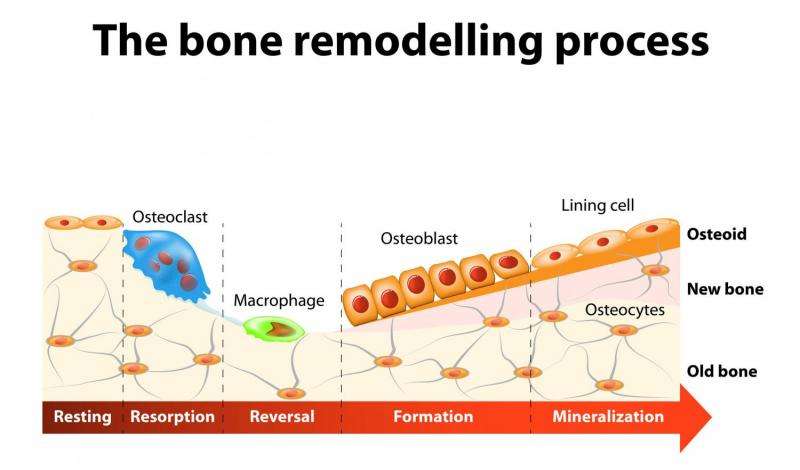The bone modeling process: In a healthy body, osteoblasts and osteoclasts work together to maintain the balance between bone loss and formation. In osteoporosis, however, this equilibrium is disrupted. Credit: designua / 123rf
Researchers from Hong Kong Baptist University and colleagues have demonstrated that a molecule called miR-214-3p plays a role in inhibiting bone formation. MiR-214-3p is a microRNA (miRNA): a non-coding RNA involved in regulating gene expression to coordinate biological processes.
The molecule was already known to be involved in regulating sugar production in the liver, in addition to playing a crucial role in skeletal disorders.
The team examined the expression of 12 miRNAs—previously reported to be involved in the regulation of bone metabolism—in whole serum, serum transport structures called 'exosomes', and bone samples from 40 elderly female patients with low-energy bone fractures. They found that the only miRNA that increased with age in all tissue samples was miR-214-3p. When they compared its levels between elderly women with and without fractures, they found they were increased in both groups but the increase was accelerated in the group with fractures. Similar results were found in aging mice from which the ovaries were removed. Bone analyses also showed a reduced rate of bone formation in these mice.
The team then examined miR-214-3p levels in genetically modified mice in which miR-214-3p was specifically 'turned on' in bone-absorbing cells known as osteoclasts. MiR-214-3p levels were increased in osteoclasts, bone tissue and serum exosomes in these mice, compared to controls, but not in other cells. These mice also had lower bone mass compared to control mice. Bone formation later increased, however, when the mice were injected with a miR-214-3p antagonist, which specifically targets miR-214-3p in osteoclasts.
The team also labelled exosomes present in osteoclasts belonging to the genetically modified mice. When these cells were cultured together with 'osteoblasts', they found evidence of labelled particles inside these bone-forming cells. Also, when mice were injected with the labelled exosomes, a fluorescent signal was detected in their bones and labelled particles were detected in their osteoblasts.
The results of the study suggest that miR-214-3p plays a role in regulating bone formation through increasing osteoclast activity and reducing osteoblast activity. MiR-214-3p is also involved in a messenger system between the two types of cells, in which it is transferred by means of exosomes from one cell type to the other.
Drugs that inhibit miR-214-3p in osteoclasts could be used as a potential strategy for reversing osteoporosis, the researchers conclude in their study published in the journal Nature Communications. The team is currently developing an innovative drug design strategy that targets miR-214, which would be applied to a series of non-coding RNA targets.
Journal information: Nature Communications
Provided by Hong Kong Baptist University



















